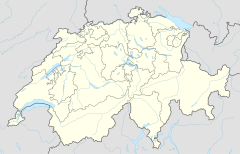
Bodrum Castle is a historical fortification located in southwest Turkey in the port city of Bodrum, built from 1402 onwards, by the Knights of St John as the Castle of St. Peter or Petronium. A transnational effort, it has four towers known as the English, French, German, and Italian towers, bearing the names of the nations responsible for their construction. The chapel was built around 1407 and the first walls completed in 1437. The castle started reconstruction in the late 14th century, only to be taken over by the Islamic Ottoman Empire in 1523. The chapel was converted to a mosque, and a minaret was added. The castle remained under the empire for almost 400 years. After remaining empty following World War I, in the early 1960s, the castle became the home for the Bodrum Museum of Underwater Archaeology. In 2016 it was inscribed in the UNESCO Tentative list of World Heritage Sites in Turkey.
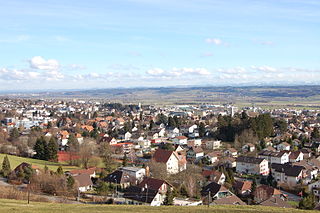
Grenchen is a municipality in the district of Lebern in the canton of Solothurn in Switzerland.
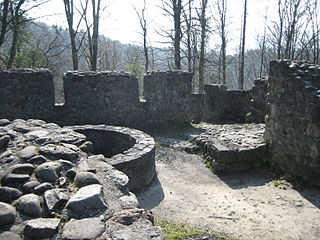
The ruins of Wulp Castle is a castle located besides Küsnachter Tobel in the municipality of Küsnacht and the canton of Zurich in Switzerland. It was built during the high Middle Ages. Despite this, the castle is documented only in a few found texts, and much of the castle's history is not known. However, in the chronicle of Muri Abbey, a castle that could perhaps fit Ruine Wulp's description - a castle in proximity to Zurich and Lake Zurich - was mentioned, but this has not been confirmed by other findings and is mere speculation. Also, a person named Eghart of Küsnacht was mentioned in the chronicle and several other documents to be the owner of the castle in the late 11th century.

Marmels Castle German: Burg Marmels is a ruined castle in the municipality of Marmorera in the district of Albula in the canton of Graubünden in Switzerland.

Anhalt Castle is a ruined medieval fortification near the town of Harzgerode in Saxony-Anhalt, Germany.

Frohberg Castle is a medieval castle ruin in the Swiss municipality of Aesch in the canton of canton of Basel-Land.

Attinghausen Castle is a ruined medieval castle in the municipality of Attinghausen in the canton of Uri in Switzerland. It is a Swiss heritage site of national significance.

Hohenrätien Castle is a castle in the municipality of Sils im Domleschg of the Canton of Graubünden in Switzerland. It is a Swiss heritage site of national significance.

Sogn Parcazi Castle and Church is a ruined castle and fortified church in the municipality of Trin of the Canton of Graubünden in Switzerland. It is a Swiss heritage site of national significance.

The ruins of the former Splügen Castle lie east of the village of Splügen in the Rheinwald forest in the Swiss canton of Graubünden. It is the only castle in the valley.

The ruins of Werdenfels Castle stand about 80 metres above the Loisach valley between Garmisch and Farchant in the county of Garmisch-Partenkirchen in Upper Bavaria. The spur castle was used until 1632 as the administrative centre of the County of Werdenfels, but began to fall into disrepair thereafter.

The Ruins of Radegg are the ruins of a spur castle built around the year 1200 in the Canton of Schaffhausen, Switzerland and destroyed around the year 1300. It is located high above the Wangental on a spur of the Rossberg which drops off steeply on three sides in Osterfingen in the municipality of Wilchingen.
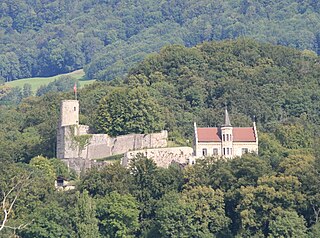
Bipp Castle is a partially ruined castle in the municipality of Oberbipp of the Canton of Bern in Switzerland.

Hasensprung Castle is a ruined castle in the municipality of Domleschg in the Viamala Region of the canton of Graubünden in Switzerland.
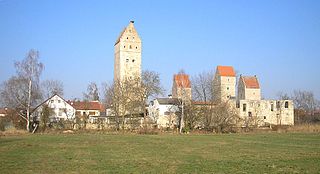
Nassenfels Castle stands at the edge of the market village of Nassenfels in the county of Eichstätt in Upper Bavaria. The former water castle is still lived in and may only be viewed from the outside.

San Peder Castle is a ruined stone tower and a ruined church in the former municipality of Sent of the Canton of Graubünden in Switzerland.

Grüneck Castle is a ruined castle in the municipality of Ilanz of the Canton of Graubünden in Switzerland.

Castelberg Castle is a ruined castle in the municipality of Ilanz/Glion of the Canton of Graubünden in Switzerland.
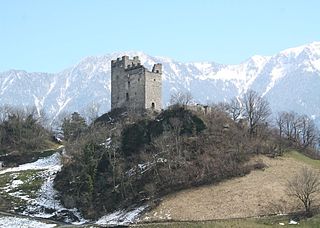
Wartau Castle is a ruined castle in the municipality of Wartau of the Canton of St. Gallen in Switzerland. It is a Swiss heritage site of national significance.

Altenberg Castle is a ruined castle in the municipality of Füllinsdorf in the canton of Basel-Land in Switzerland.

